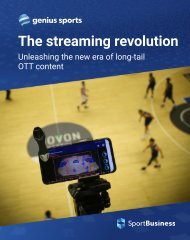SportBusiness Streaming Whitepaper Digital
Create successful ePaper yourself
Turn your PDF publications into a flip-book with our unique Google optimized e-Paper software.
In association with GENIUS SPORTS<br />
RISE OF AUTOMATED PRODUCTION<br />
The most important development in enabling all levels of sport to stream their content has been the emergence<br />
of automated production systems. Being able to automatically track the live action, identify highlights, embed<br />
statistics and insert adverts and sponsorship opportunities was far beyond even the most advanced streaming<br />
solutions five years ago.<br />
STREAMING: SMARTPHONES’ NEXT FRONTIER<br />
On top of the onerous production and resource costs, to go over the top sports would historically have to cover<br />
the significant hardware expenditure of cameras in multiple different venues.<br />
But both in and out of sport, the intervening period has seen huge progress in the field of artificial intelligence<br />
and computer vision. Whether by embedded chips in players’ shoes and the ball or advanced motion sensors to<br />
track the flow of play, democratised tracking technology has changed the game in sports streaming.<br />
Sports of all sizes now have tools at their disposal that can automatically track, pan and zoom with every<br />
play while cutting between multiple cameras positioned around the pitch or court. These solutions weren’t<br />
immediately perfect: differentiating between major crowd movements, stitching a high- quality picture together<br />
with multiple angles and ensuring reliable, low latency streams have all been significant challenges in the<br />
emergence of automated solutions.<br />
Smartphones, however, have had a transformative effect on modern sport, making every league, federation, club<br />
and fan an instant content producer. Fans rely on their mobile phone to capture live streams and photos at a<br />
game and quickly consume everything from odds to scores, highlights, statistics, news and interviews when they<br />
are on-the-go.<br />
But by eliminating the need for<br />
in- venue directors, cameramen<br />
and other production staff,<br />
automated production removes a<br />
once insurmountable barrier to<br />
entry. Powered by cloud-based<br />
technology which simplifies how<br />
sports manage and distribute their<br />
content while processing billions of<br />
data points, these solutions are<br />
transforming the production of<br />
live sports.<br />
Because producing and distributing<br />
content in the cloud is simpler and less<br />
expensive, it lowers the barriers for<br />
“smaller sports organisations.”<br />
As Mehul Padaia, vice-president of global marketing at Tata Communications, told Raconteur last year: “The<br />
cloud is levelling the playing field between sports giants like F1 and smaller local series like the F4 British<br />
Championship. You only need a few cameras to capture the action; the rest of the production can be done easily<br />
and inexpensively in the cloud.<br />
This opens up a global market for local sports leagues … Also, because producing and distributing content in the<br />
cloud is simpler and less expensive, it lowers the barriers for smaller sports organisations.”<br />
Long-tail sports launching their first OTT platform shouldn’t immediately expect a TV-level of production. But<br />
automated solutions have opened an unprecedented window of opportunity, enabling them to showcase their<br />
gamesfor the first time while controlling when their events are played, how their video content is delivered<br />
across multiple platforms and the tools they want to use to enhance every stream and highlight.<br />
<strong>Streaming</strong> is the next frontier for smartphones’ increasing impact on modern sport. Across post-match<br />
interviews by journalists, clubs filming behind-the-scenes content and coaches analysing performance, their<br />
video content is already relied upon every day.<br />
Smartphones are providing all sports with an affordable and accessible streaming solution that replaces<br />
expensive hardware, driven by their increased camera quality, computing power and instant distribution<br />
capabilities via the cloud.<br />
Rights-holders entering the OTT market can be sceptical of the quality and reliability of mobile solutions to<br />
deliver low-latency streams that capture the excitement of live sport.<br />
www.sportbusiness.com | @<strong>SportBusiness</strong> 3















